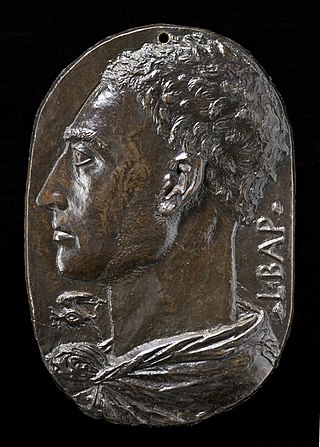
Leon Battista Alberti was an Italian Renaissance humanist author, artist, architect, poet, priest, linguist, philosopher, and cryptographer; he epitomised the nature of those identified now as polymaths. He is considered the founder of Western cryptography, a claim he shares with Johannes Trithemius.

The Oltrarno is a quarter of Florence, Italy. It is located south of the River Arno. It contains part of the historic centre of Florence and many notable sites such as the church Santo Spirito di Firenze, Palazzo Pitti, Belvedere, and Piazzale Michelangelo.

The Museo Nazionale della Magna Grecia, Museo Archeologico Nazionale di Reggio Calabria or Palazzo Piacentini is a museum in Reggio Calabria, southern Italy, housing an archaeological collection from sites in Magna Graecia.

Palazzo Gherardi is a 15th-century building in the Santa croce quarter of Florence, Tuscany, in central Italy. Its main façade is on Via Ghibellina 88, while to the right it faces Via dei Pepi.

Palazzo Castiglioni is an Art Nouveau palace of Milan, northern Italy. It was designed by Giuseppe Sommaruga in the Liberty style and built between 1901 and 1903. The rusticated blocks of the basement imitate a natural rocky shape, while the rest of the decorations are inspired by 18th century stuccos. The building is now used as the seat of the Unione Commercianti di Milano.

Paolo Del Bianco, is president of the Romualdo Del Bianco Foundation, member of the ICOMOS Hungary Committee, member of the ICOMOS International Scientific Committee for Theory and Philosophy of Conservation and Restoration, honorary member of the ICOMOS International Scientific Committee for Mural Paintings, promoter and founder of Life Beyond Tourism Non Profit Portal, President of Centro Congressi al Duomo - CCAD Firenze affiliate member UNWTO.

The Gottifredo Palace is a large medieval house in Alatri in the Lazio Region of Italy. It lies at the confluence of the main streets of Alatri at the time of the palace's construction: the first, coming from the north city gate of San Pietro; the second, from west, arrives from the ancient Via San Francesco which passes through the gate of the same name; the third from gate St Nicholas, to the east.
The Palazzo Marigliano, also known as Palazzo di Capua is a Renaissance-style palace in Central Naples, Italy. It is located on the Via San Biagio dei Librai number 39.

The Sala delle Asse, is a large room in the Castello Sforzesco in Milan, the location of a painting in tempera on plaster by Leonardo da Vinci, dating from about 1498. Its walls and vaulted ceiling are decorated with "intertwining plants with fruits and monochromes of roots and rocks" and a canopy created by sixteen trees.

The Palazzo Chigi all Postierla, but sometimes referred also to as Chigi-Piccolomini or Piccolomini-Adami is a Renaissance style urban palace localized on Via del Capitano #1, corner Piazza Postierla, in the Terzo di Città, in the city of Siena, region of Tuscany, Italy. The palace is up the street from the Palazzo del Capitano del Popolo, Siena.

Monastero delle Murate is a former Benedictine convent on Via Ghibellina in Florence, Italy. For about a hundred years, from 1883 to 1985, it was the men's prison in Florence, after which the detainees were transferred to Sollicciano and other facilities. Since the 21st century, it has served as a restaurant and meeting places, with additional apartments, bars, restaurants and shops. The religious community dates to 1370 when 12 women became voluntarily reclusive in a shack by the second pillar of the Ponte Rubaconte, praying and living on alms in extremely difficult conditions. Given the growth in the number of sisters, in 1424, Giovanni de 'Benci, who lived nearby, financed the construction of a new, larger monastery near the walls, called the Most Holy Annunciation and St. Catherine. The monastery was renovated and expanded for the first time in 1471, following a fire, and then in 1571, after a flood. Supporters included Lorenzo de' Medici. Also in 1509 Caterina Sforza was buried in the monastery.

Sebastiano Giuseppe Locati was an Italian architect. He became famous at the turn of the twentieth century for his efforts in designing structures in eclectic and Art Nouveau styles.
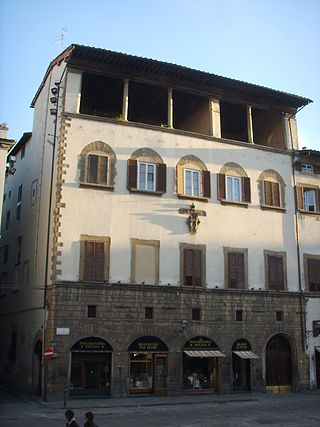
Palazzo Della Stufa or Lotteringhi Della Stufa, is in the Piazza San Lorenzo, at the corner of Via della Stufa, in Florence, Italy, in front of the Basilica di San Lorenzo.

The palazzo Belimbau, also known as palazzo Antoniotto Cattaneo or Palazzo Francesco De Ferrari, is a building located in Piazza della Nunziata at number 2 in Genoa, included on 13 July 2006 in the list of the 42 palaces inscribed in the Rolli di Genova that became World Heritage by UNESCO on that date.

Palazzo Bezzoli, or Del Bembo or Martelli, is a civic building in the historical centre of Florence, located between via dei Cerretani 11r-13r-15r-17r-19r and piazza dell'Olio 3. The palazzo appears in the list drawn up in 1901 by the General Directorate of Antiquities and Fine Arts, as a monumental building to be considered national artistic heritage (Italy).
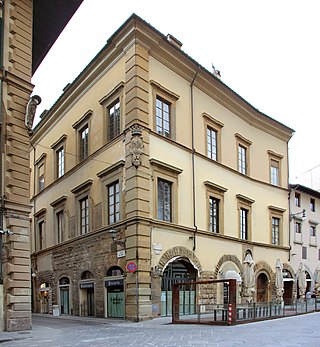
The Palazzo Naldini, or Naldini Del Riccio', or also Niccolini al Duomo, is a Florence palace located on the corner of Piazza del Duomo 28 rosso and Via dei Servi 2–4.
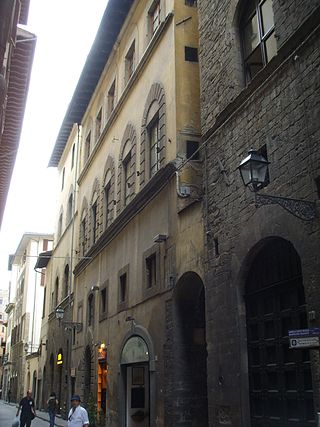
The Casa Acciaiuoli was one of the Acciaiuoli family's palaces in Florence, located at Borgo Santi Apostoli 10 corner Chiasso Cornino 1r.
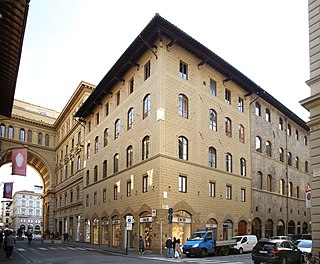
Palazzo Anselmi Ristori is a building in the historical centre of Florence, located between via de' Sassetti 6 and via degli Strozzi 9r-11r-13r-15r-17r-19r.
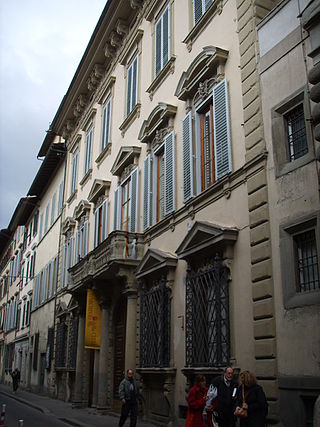
Palazzo Bastogi is located at Via dell'Oriuolo 33 in Florence. It houses the Historical Archive of the City of Florence. The palazzo appears in the list drawn up in 1901 by the General Directorate of Antiquities and Fine Arts as a monumental building to be considered.

The palazzo dell’Arcone di Piazza is a civil building in the historical centre of Florence, located at Piazza della Repubblica 5, corner Via degli Anselmi 2, Via Pellicceria, Via degli Strozzi 1- 2, Via de' Brunelleschi 5.





















